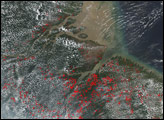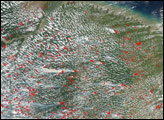

Late in the dry season near the mouth of the Amazon River in Brazil, numerous fires were burning when the Moderate Resolution Imaging Spectroradiometer (MODIS) on NASA’s Aqua satellite captured this image on November 22, 2004. Locations where MODIS detected active fires are marked in red. It’s surprising to many people that the Amazon Rainforest even has a dry season, but in fact there are places that go months each year with little or no rain. In this part of the Amazon, the rainy season won’t get fully underway until January.
Before widespread human settlement and agricultural development in and around the Amazon, forest fires were extremely rare: an area might have experienced fire once every few centuries. The forest survives the dry season by tapping water many meters down in the soil, and there were few natural triggers for fires becuase lightning is almost always accompanied by rain. Today, the forests are under pressure from both intentional and accidental fires caused by humans. For more about how fire is changing the Amazon Rainforest, please read the feature story “From Forest to Field.”
NASA image created by Jesse Allen, Earth Observatory, using data obtained from the MODIS Rapid Response team.
This Aqua MODIS image shows fires burning near the mouth of the Amazon River in the late dry season on November 22, 2004.

